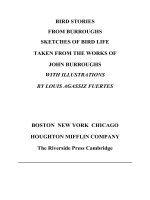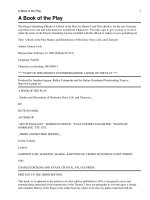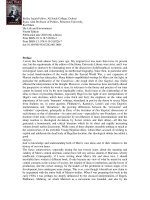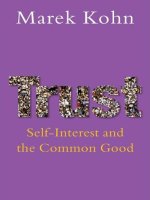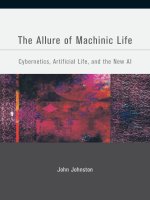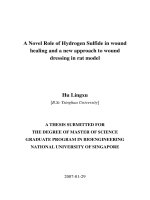the allure of machinic life cybernetics artificial life and the new ai sep 2008
Bạn đang xem bản rút gọn của tài liệu. Xem và tải ngay bản đầy đủ của tài liệu tại đây (4.4 MB, 477 trang )
The Allure of Machinic Life
Cybernetics, Artificial Life, and the New AI
John Johnston
The Allure of Machinic Life
Cybernetics, Artificial Life, and the New AI
John Johnston
In The Allure of Machinic Life, John Johnston examines new
forms of nascent life that emerge through technical inter-
actions within human-constructed environments —“machinic
life” —in the sciences of cybernetics, artificial life, and artificial
intelligence. With the development of such research initiatives
as the evolution of digital organisms, computer immune sys-
tems, artificial protocells, evolutionary robotics, and swarm
systems, Johnston argues, machinic life has achieved a com-
plexity and autonomy worthy of study in its own right.
Drawing on the publications of scientists as well as a
range of work in contemporary philosophy and cultural theory,
but always with the primary focus on the “objects at hand” —
the machines, programs, and processes that constitute ma-
chinic life— Johnston shows how they come about, how they
operate, and how they are already changing. This under-
standing is a necessary first step, he further argues, that
must precede speculation about the meaning and cultural
implications of these new forms of life.
Developing the concept of the “computational assem-
blage” (a machine and its associated discourse) as a frame-
work to identify both resemblances and differences in form
and function, Johnston offers a conceptual history of each of
the three sciences. He considers the new theory of machines
proposed by cybernetics from several perspectives, includ-
ing Lacanian psychoanalysis and “machinic philosophy.” He
examines the history of the new science of artificial life and
its relation to theories of evolution, emergence, and complex
adaptive systems (as illustrated by a series of experiments
carried out on various software platforms). He describes the
history of artificial intelligence as a series of unfolding con-
ceptual conflicts— decodings and recodings—leading to a
“new AI” that is strongly influenced by artificial life. Finally, in
examining the role played by neuroscience in several con-
temporary research initiatives, he shows how further success
in the building of intelligent machines will most likely result
from progress in our understanding of how the human brain
actually works.
John Johnston is Professor of English and Comparative Litera-
ture at Emory University in Atlanta. He is the author of Carnival
of Repetition and Information Multiplicity.
Cover image:
Joseph Nechvatal, ignudiO gustO majOr, computer-robotic-assisted acrylic on
canvas, 66” x 120”. Photo courtesy Galerie Jean-Luc & Takako Richard.
© 2003 Joseph Nechvatal.
A Bradford Book
The MIT Press Massachusetts Institute of Technology Cambridge, Massachusetts 02142
978-0-262-10126-4
Johnston The Allure of Machinic Life
“John Johnston is to be applauded for his engaging and eminently readable assessment of the
new, interdisciplinary sciences aimed at designing and building complex, lifelike, intelligent
machines. Cybernetics, information theory, chaos theory, artificial life, autopoiesis, connection-
ism, embodied autonomous agents— it’s all here!”
— Mark Bedau, Professor of Philosophy and Humanities, Reed College, and Editor-in-Chief,
Artificial Life
Of related interest
How the Body Shapes the Way We Think
A New View of Intelligence
Rolf Pfeifer and Josh Bongard
How could the body influence our thinking when it seems obvious that the brain controls the
body? In How the Body Shapes the Way We Think, Rolf Pfeifer and Josh Bongard demon-
strate that thought is not independent of the body but is tightly constrained, and at the same
time enabled, by it. They argue that the kinds of thoughts we are capable of have their foun-
dation in our embodiment— in our morphology and the material properties of our bodies.
What Is Thought?
Eric B. Baum
In What Is Thought? Eric Baum proposes a computational explanation of thought. Just as
Erwin Schrödinger in his classic 1944 work What Is Life? argued ten years before the dis-
covery of
DNA that life must be explainable at a fundamental level by physics and chemistry,
Baum contends that the present-day inability of computer science to explain thought and
meaning is no reason to doubt that there can be such an explanation. Baum argues that the
complexity of mind is the outcome of evolution, which has built thought processes that act
unlike the standard algorithms of computer science, and that to understand the mind we
need to understand these thought processes and the evolutionary process that produced
them in computational terms.
computer science/artificial intelligence
The Allure of Machinic Life
THE ALLURE OF MACHINIC LIFE
Cybernetics, Artificial Life, and the New AI
John Johnston
A Bradford Book
The MIT Press
Cambridge, Massachusetts
London, England
6 2008 Massachusetts Institute of Technology
All rights reserved. No part of this book may be reproduced in any form by any electronic or
mechanical means (including photocopying, recording, or information storage and retrieval)
without permission in writing from the publisher.
For information about special quantity discounts, please email
.edu
This book was set in Times New Roman and Syntax on 3B2 by Asco Typesetters, Hong
Kong.
Printed and bound in the United States of America.
Library of Congress Cataloging-in-Publication Data
Johnston, John Harvey, 1947–
The allure of machinic life : cybernetics, artificial life, and the new AI / John Johnston
p. cm.
Includes bibliographical references and index.
ISBN 978-0-262-10126-4 (hardcover : alk. paper)
1. Cybernetics. 2. Artificial life. 3. Artificial intelligence. I. Title.
Q310.J65 2008
003
0
.5—dc22 2008005358
10987654321
For Heidi
Contents
Preface ix
Introduction 1
I FROM CYBERNETICS TO MACHINIC PHILOSOPHY 23
1 Cybernetics and the New Complexity of Machines 25
2 The In-Mixing of Machines: Cybernetics and Psychoanalysis 65
3 Machinic Philosophy: Assemblages, Information, Chaotic Flow 105
II MACHINIC LIFE 163
4 Vital Cells: Cellular Automata, Artificial Life, Autopoiesis 165
5 Digital Evolution and the Emergence of Complexity 215
III MACHINIC INTELLIGENCE 275
6 The Decoded Couple: Artificial Intelligence and Cognitive Science 277
7 The New AI: Behavior-Based Robotics, Autonomous Agents, and
Artificial Evolution 337
8 Learning from Neuroscience: New Prospects for Building Intelligent
Machines 385
Notes 415
Index 453
Preface
This book explores a single topic: the creation of new forms of ‘‘machinic
life’’ in cybernetics, artificial life (ALife), and artificial intelligence (AI).
By machinic life I mean the forms of nascent life that have been made to
emerge in and through technical interactions in human-constructed envi-
ronments. Thus the webs of connection that sustain machinic life are
material (or virtual) but not directly of the natural world. Although au-
tomata such as the eighteenth-century clockwork dolls and other figures
can be seen as precursors, the first forms of machinic lif e appeared in the
‘‘lifelike’’ machines of the cyberneticists and in the early programs and
robots of AI. Machinic life, unlike earlier mechanical forms, has a capac-
ity to alter itself and to respond dynamically to changing situations.
More sophisticated forms of machinic life appear in the late 1980s and
1990s, with computer simulations of evolving digital organisms and the
construction of mobile, autonomous robots. The emergence of ALife as
a scientific discipline—which o‰cially dates from the conference on ‘‘the
synthesis and simulation of living systems’’ in 1987 organized by Christo-
pher Langton—and the growing body of theoretical writings and new
research initiatives devoted to autonomous agents, computer immune
systems, artificial protocells, e volutionary robotics, and swarm systems
have given the development of machinic life further momentum, solidity,
and variety. These developments make it increasingly clear that while
machinic life may have begun in the mimicking of the forms and pro-
cesses of natural organic life, it has achieved a complexity and autonomy
worthy of study in its own right. Indeed, this is my chief argument.
While excell ent books and artic les devoted to these topics abound,
there has been no attempt to consider them wi thin a single, overarching
theoretical framework. The challenge is to do so while respecting the
very significant historical, conceptual, scientific, and technical di¤erences
in this material and the diverse perspectives they give rise to. To meet this
challenge I have tried to establish an inclusive vantage point that can be
shared by specialized and general readers alike. At first view, there are
obvious relations of precedence and influence in the distinctive historie s
of cybernetics, AI, and ALife. Without the groundbreaking discoveries
and theoretical orientation of cybernetics, the sciences of AI and ALife
would simply not have arisen and developed as they have. In both, more-
over, the digital computer was an essential condition of possibility. Yet
the development of the stored-program electronic computer was also con-
temporary with the birth of cybernetics and played multiple roles of
instigation, example, and relay for many of its most important conceptu-
alizations. Thus the centrality of the computer results in a complicated
nexus of historical and conceptual relationships among these three fields
of research.
But while the computer has been essential to the dev elopment of all
three fields, its role in each has been di¤erent. For the cyberneticists the
computer was first and foremost a physical device used primarily for cal-
culation and control; yet because it could exist in a nearly infinite number
of states, it also exhibited a new kind of complexity. Early AI would de-
marcate itself from cybernetics precisely in its highly abstract understand-
ing of the computer as a symbol processor, whereas ALife would in turn
distinguish itself from AI in the ways in which it would understand the
role and function of computation. In contrast to the top-down compu-
tational hierarchy posited by AI in its e¤ort to produce an intelligent
machine or program, ALife started with a highly distributed population
of computational machines, from which complex, lifelike behaviors could
emerge.
These di¤erent understandings and uses of the computer demand a pre-
cise conceptualization. Accordingly, my concept of computational assem-
blage provides a means of pinpointing underlying di¤erences of form and
function. In this framework, every computational machine is conceived of
as a material assemblage (a physical device) conjoined with a unique dis-
course that explains and justifies the machine’s operation and purpose.
More simply, a computational assemblage is comprised of both a ma-
chine and its associated discourse, which together determine how and
why this machine does what it does. The concept of computational as-
semblage thus functions as a di¤erentiator within a large set of family
resemblances, in contrast to the general term computer, which is too
vague for my purposes. As with my concept of machinic life, these family
resemblances must be spelled out in detail. If computational asse mblages
comprise a larger unity, or indeed if forms of machinic life can be said to
x Preface
possess a larger unity, then in both cases they are unities-in-di¤erence,
which do not derive from any preestablished essence or ideal form. To
the contrary, in actualizing new forms of computation and life, the
machines and programs I describe constitute novel ramifications of an
idea, not further doublings or repetitions of a prior essence.
This book is organized into three parts, which sketch conceptual his-
tories of the three sciences. Since I am primarily concerned with how
these sciences are both unified and di¤erentiated in their productions of
machinic life, my presentation is not strictly chronological. As I demon-
strate, machinic life is fully comprehensible only in relation to new and
developing notions of complexity, information processing, and dynamical
systems theory, as well as theories of emergence and evolution; it thus
necessarily crosses historical and disciplinary borderlines. The introduc-
tion traces my larger theoretical trajectory, focusing on key terms and
the wider cultural context. Readers of N. Katherine Hayles, Manual
DeLanda, Ansel Pearson, Paul Edwards, and Richard Doyle as well as
books about Deleuzian philosophy, the posthuman, cyborgs, and cyber-
culture more generally will find that this trajectory passes over familiar
ground. However, my perspective and purpose are distinctly di¤erent.
For me, what remains uppermost is staying close to the objects at
hand—the machines, programs, and processes that constitute machinic
life. Before speculating about the cultural implications of these new kinds
of life and intelligence, we need to know precisely how they come about
and operate as well as how they are already changing.
In part I, I consider the cybernetic movement from three perspectives.
Chapter 1 makes a case for the fundam ental complexity of cybernetic
machines as a new species of automata, existing both ‘‘in the metal and
in the flesh,’’ to use Norbert Wiener’s expression, as built and theorized
by Claude Shannon, Ross Ashby, John von Neumann, Grey Walter,
Heinz von Foerster, and Valentino Braitenberg. Chapter 2 examines the
‘‘cybernetic subject’’ through the lens of French psychoanalyst Jacques
Lacan and his participation (along with others, such as Noam Chomsky)
in a new discourse network inaugurated by the confluence of cybernetics,
information theory, and automata theory. The chapter concludes with a
double view of the chess match between Gary Kasparov and Deep Blue,
which suggests both the power and limits of classic AI. Chapter 3 extends
the cybernetic perspective to what I call machinic philosophy, evident in
Deleuze and Guattari’s concept of the assemblage and its intersections
with nonlinear dynamical systems (i.e., ‘‘chaos’’) theory. Here I develop
more fully the concept of the computation al assemblage, specifically in
Preface xi
relation to Robert Shaw’s ‘‘dripping faucet as a model chaotic system ’’
and Jim Crutchfield’s -machine (re)construction.
Part II focuses on the new science of ALife, beginning with John von
Neumann’s theory of self-reproducing automata and Christopher Lang-
ton’s self-reproducing digital loops. Langton’s theory of ALife as a new
science based on computer simulations whose theoretical underpinnings
combine information theory with dynamical systems theory is contrasted
with Francisco Varela and Humberto Maturana’s theory of autopoiesis,
which leads to a consideration of both natural and artificial immune
systems and computer viruses. Chapter 5 charts the history of ALife
after Langton in relation to theories of evolution, emergen ce, and com-
plex adaptive systems by examining a series of experiments carried out
on various software platforms, including Thomas Ray’s Tierra, John
Holland’s Echo, Christoph Adami’s Avida, Andrew Pargellis’s Amoeba,
Tim Taylor’s Cosmos, and Larry Yaeger’s PolyWorld. The chapter con-
cludes by considering the limits of the first phase of ALife research and
the new research initiatives represented by ‘‘living computation’’ and
attempts to create an artificial protocell.
Part III takes up the history of AI as a series of unfolding conceptual
conflicts rather than a chronological narrative of achievements and fail-
ures. I first sketch out AI’s familiar three-stage development, from sym-
bolic AI as exemplified in Newel and Simon’s physical symbol system
hypothesis to the rebirth of the neural net approach in connectionism
and parallel distributed processing and to the rejection of both by a
‘‘new AI’’ strongly influenced by ALife but concentrating on building
autonomous mobile robots in the noisy physical world. At e ach of AI’s
historical stages, I sug gest, there is a circling back to reclaim ground or a
perspective rejected earlier—the biologically oriented neural net approach
at stage two, cybernetics and embodiment at stage three. The decodings
and recodings of the first two stages lead inevitably to philosophical
clashes over AI’s image of thought— symbol manipulation versus a sto-
chastically emergent mentality— and the possibility of robotic conscious-
ness. On the other hand, the behavior-based, subsumption-style approach
to robotics that characterizes the new AI eventually has to renege on its
earlier rejection of simulation when it commits to artificial evolution as a
necessary method of development. Finally, in the concluding chapter, I
indicate why further success in the building of intelligent machines will
most likely be tied to progress in our understanding of how the human
brain actually works, and describe recent example s of robotic self-
modeling and communication.
xii Preface
In writing this book I have been stimulated, encouraged, challenged, and
aided by many friends, colleagues, and scientists generous enough to
share their time with me. Among the latter I would especially like to
thank Melanie Mitchell, whose encouragement and help at the project’s
early stages were essential, Luis Rocha, Jim Crutchfield, Cosma Shalizi,
Christoph Adami, David Ackley, Steen Rasmussen, Steve Grand, and
Mark Bedau. Among friends and colleagues who made a di¤erence I
would like to single out Katherine Hayles, Michael Schippling, Tori
Alexander, Lucas Beeler, Gregory Rukavina, Geo¤ Bennington, Tim
Lenoir, Steve Potter, Jeremy Gilbert-Rolfe, and Bob Nelson. This work
was facilitated by a one-semester gran t from the Emory University Re-
search Committee and a one-semester sabbatical leave. Warm apprecia-
tion also goes to Bob Prior at MIT Press for his always helpful and
lively commitment to this project.
This book would not have seen the light of day without the always sur-
prising resourcefulness, skills as a reader and critical thinker, and unflag-
ging love and support of my wife, Heidi Nordberg. I dedicate it to her.
Preface xiii
Introduction
The electric things have their lives, too.
—Philip K. Dick, Do Androids Dream of Electric Sheep?
Liminal Machines
In the early era of cybernetics and information theory following the Sec-
ond World War, two distinctively new types of machine appeared. The
first, the computer, was initially associated with war and death—breaking
secret codes and calculating artillery trajectories and the forces required
to trigger atomic bombs. But the second type, a new kind of liminal ma-
chine, was associated with life, inasmuch as it exhibited many of the
behaviors that characterize living entities—homeostasis, self-directed
action, adaptability, and reproduction. Neither fully alive nor at all inan-
imate, these liminal machines exhibited what I call machinic life, mirror-
ing in purposeful action the behavior associated with organic life while
also suggesting an altogether di¤erent form of ‘‘life,’’ an ‘‘artificial’’ alter-
native, or parallel, not fully answerable to the ontological priority and
sovereign prerogatives of the organic, biological realm. First produced
under the aegis of cybernetics and proliferating in ALife research and
contemporary robotics, the growing list of these mach ines would include
John von Neumann’s self-reproducing automata, Claude Shannon’s
maze-solving mouse, W. Ross Ashby’s self-organizing homeostat, W.
Grey Walter’s artificial tortoises, the digital organisms that spawn and
mutate in ALife virtual worlds, smart software agents, and many autono-
mous mobile robots. In strong theories of ALife these machines are
understood not simply to simulate life but to realize it, by instantiating
and actualizing its fundamental principles in anot her medium or material
substrate. Consequently, these machines can be said to inhabit, or ‘‘live,’’ in
a strange, newly animated realm, where the biosphere and artifacts from
the human world touch and pass into each other, in e¤ect constituting
a ‘‘machinic phylum.’’1 The increasing number and variety of forms of
machinic life suggest, moreover, that this new realm is steadily expanding
and that we are poised on the brink of a new era in which nature and
technology will no longer be distinctly opposed.
Conjoining an eerie and sometimes disturbing abstractness with lifelike
activity, these liminal machines are intrinsically alluring. Yet they also re-
veal conceptual ambitions and tensions that drive some of the most inno-
vative sectors of contemporary science. For as we shall see, these forms of
machinic life are characterized not by any exact imitation of natural life
but by complexity of behavior.2 Perhaps it is no longer surprising that
many human creations—including an increasing numbers of machines
and smart systems—exhibit an order of complexity arguably equal to or
approaching that of the simplest natural organisms. The conceptual re-
orientation this requires—that is, thinking in terms of the complexity of
automata, whether natural or artificial, rather than in terms of a natural
biological hierarchy—is part of the legacy of cybernetics. More specifi-
cally, in the progression from the cybernetic machines of von Neumann,
Ross Ashby, and Grey Walter to the computer-generated digital organ-
isms in ALife research and the autonomous mobile robots of the 1990s,
we witness a developmental trajectory impelled by an interest in how
interactions among simple, low-level elements produce the kinds of com-
plex behavior we associate with living systems. As the first theorist of
complexity in this sense, von Neumann believed that a self-reproducing
automaton capable of evolution would inevitably lead to the breaking of
the ‘‘complexity barrier.’’ For Ashby, complexity resulted from coupling
a simple constructed dynamical system to the environment, thereby creat-
ing a larger, more complex system. For Walter, the complex behavior
of his mobile electromechanical tortoises followed from a central design
decision to make simple elements and networks of connections serve
multiple purposes. For Christopher Langton, Thomas Ray, Chris Adami,
and many others who have used computers to generate virtual worlds in
which digital organisms replicate, mutate, and evolve, complexity emerges
from the bottom up, in the form of unpredictable global behaviors result-
ing from the simultaneous interactions of many highly distributed local
agents or ‘‘computational primitives.’’3 Relayed by the successes of
ALife, the ‘‘new AI’’ achieves complexity by embedding the lessons of
ALife simulations in autonomous machines that move about and do
unexpected things in the noisy material world. More recently, several
initiatives in the building of intelligent machines have reoriented their
2 Introduction
approach to emulate more exactly the complex circuits of information
processing in the brain.
For the most part, discussion of these liminal machines has been
defined and limited by the specific scientific and technological contexts in
which they were constructed. Yet even when discussion expands into the
wider orbits of cultural and philosophical analysis, all too often it remains
bound by the ligatures of a di¤use and seldom questioned anthropomor-
phism. In practice this means that questions about the functionality and
meaning of these machines are always framed in mimetic, representa-
tional terms. In other words, they are usually directed toward ‘‘life’’ as
the ultimate reference and final arbiter: how well do these machines
model or simulate life and thereby help us to understand its (usually
assumed) inimitable singularity? Thus if a mobile robot can move around
and avoid obstacles, or a digital organism replicate and evolve, these
activities and the value of the machinic life in question are usually gauged
in relation to what their natural organic counterparts can do in what phe-
nomenologists refer to as the life world. Yet life turns out to be very di‰-
cult to define, and rigid oppositions like organic versus nonorganic are
noticeably giving way to sliding scales based on complexity of organiza-
tion and adaptability. While contemporary biologists have reached no
consensus on a definition of life, there is wi de agreement that two basic
processes are involved: some kind of metabolism by which energy is
extracted from the environment, and reproduction with a hereditary
mechanism that will evolve adaptations for survival.4 In approaches to
the synthesis of life, however, the principal avenues are distinguished by
the means employed: hardware (robotics), software (replicating and
evolving computer programs), and wetware (replicating and e volving ar-
tificial protocells).
By abstracting and reinscribing the logic of life in a medium other than
the organic medium of carbon-chain chemistry, the new ‘‘sciences of the
artificial’’ have bee n able to produce, in various ways I explore, a com-
pletely new kind of entity.5 As a consequence these new sciences neces-
sarily find themselves positioned between two perspectives, or semantic
zones, of overlapping complexity: the metaphysics of life and the history
of technical objects. Paradoxically, the new sciences thus open a new
physical and conceptual space between realms usually assumed to be sep-
arate but that now appear to reciprocally codetermine each other. Just as
it doesn’t seem farfetched in an age of cloning and genetic engineering to
claim that current definitions of life are determined in large part by the
state of contemporary technology, so it would also seem plausible that
Introduction 3
the very di¤erences that allow and support the opposition between life
and technical objects—the organic and inorganic (or fluid and flexible
versus rigid and mechanical), reproduction and replication, phusis and
techne
¯
—are being redefined and redistributed in a biotechnical matrix
out of which machinic life is visibly emerging.6 This redistribution col-
lapses boundaries and performs a double inversion: nonorganic machines
become self-reproducing, and biological organisms are reconceived as
autopoietic machines. Yet it is not only a burgeoning fecun dity of
machinic life that issues from this matrix, but a groundbreaking expan-
sion of the theoretical terrain on which the interactions and relations
among computation (or information processing), nonlinear dynamical
systems, and evolution can be addressed. Indeed, that artificial life oper-
ates as both relay for and privileged instance of new theoretical orienta-
tions like complexity theory and complex adaptive systems is precisely
what makes it significant in the eyes of man y scientists.
As with anything truly new, the advent of machinic life has been
accompanied by a slew of narratives and contextualizations that attempt
to determine how it is to be received and understood. The simplest narra-
tive, no doubt, amounts to a denial that artificial life can really exist or be
anything more than a toy world artifact or peripheral tool in the armoire
of theoretical biology, software engineering, or robotics. Proceeding from
unquestioned and thoroughly conventionalized assumptions about life,
this narrative can only hunker down and reassert age-old boundaries,
rebuilding fallen barriers like so many worker ants frenetically shoring
up the sides of a crumbling ant hill. The message is always the same: arti-
ficial life is not real life. All is safe. There is no need to rethink categories
and build new conceptual sca¤oldings. Yet it was not so long ago that
Michel Foucault, writing about the conditions of possibility for the sci-
ence of biology, reminded us that ‘‘life itself did not exist’’ before the end
of the eighteenth century; instead, there were only living beings, under-
stood as such because of ‘‘the grid of knowledge constituted by natural
history.’’7 As Foucault makes clear, life could only emerge as a unifying
concept by becoming invisible as a process, a secret force at work within
the body’s depths. To go very quickly, this notion of life followed from
a more precise understanding of death , as revealed by a new mode of
clinical perception made possible by anatomical dissection.8 Indeed, for
Xavier Bichat, whose Treatise on Membranes (1807) included the first
analysis of pathological tissue, life was simply ‘‘the sum of the functions
that oppose death.’’ One of the first modern cultural narratives about
4 Introduction
artificial life, Mary Shelley’s Frankenstein (1819), was deeply influenced
by the controversies this new perspective provoked.9
At its inception, molecul ar biology attempted to expunge its remaining
ties to a vestigial vitalism—life’s secret force invisibly at work—by reduc-
ing itself to analysis of genetic programming and the machinery of cell
reproduction and growth. But reproduction only perpetuates life in its
unity; it does not create it. Molecular biology remains metaphysical, how-
ever, insofar as it disavows the conditions of its own possibility, nam ely,
its complete dependence on information technology or bioinformatics.10
The Human Genome Project emblazons this slide from science to meta-
physics in its very name, systematically inscribing ‘‘the human’’ in the
space of the genetic code that defines the anthropos.InLa technique et le
temps, Bernard Stiegler focuses on this disavowal, drawing attention to a
performative dimension of scientific discourse usually rendered invisible
by the e‰cacy of science itself.11 Stiegler cites a passage from Franc¸ois
Jacob’s The Logic of Life: A History of Heredity, in which Jacob, con-
trasting the variations of human mental memory with the invariance of
genetic memory, emphasizes that the genetic code prevents any changes
in its ‘‘program’’ in response to either its own actions or any e¤ects in
the environment. Since only random mutation can bring about change,
‘‘the programme does not learn from experience’’ (quoted in Stiegler,
176). Explicitly, for Jacob, it is the autonomy and inflexibility of the
DNA code, not th e contingencies of cultural memory, that ensure the
continued identity of the human. Jacob’s position, given considerable
weight by the stunning successes of molecular biology—including Jacob’s
own Nobel Prize–winning research with Jacques Monod and Andre
´
Lwo¤ on the genetic mechanisms of E. coli—soon became the new ortho-
doxy. Yet, as Stiegler points out, within eight years of Jacob’s 1970 pro-
nouncement the invention of gene-splicing suspended this very axiom.
(Jacob’s view of the DNA code is axiomatic because it serves as a foun-
dation for molecular biology and generates a specific set of experimental
procedures.) Thus since 1978 molecular biology has proceeded with its
most fundamental axiom held to be true in theory even while being vio-
lated in practice.12
A great deal of more recent research, however, has challenged this
orthodoxy, both in terms of the ‘‘invariance’’ of the genome and the way
in which the genome works as a ‘‘program.’’ And in both cases these
challenges parallel and resonate with ALife research. In regard to the
supposed invariance, Lynn Helena Caporale has presented compelling
Introduction 5
evidence against the view that the genome is rigidly fixed except for
chance mutations. Species’ survival, she argues, depends more on diversity
in the genome than inflexibility. In this sense the genome itself is a com-
plex adaptive system that can anticipate and respond to change. Caporale
finds that certain areas of the genome, like those that encode immune re-
sponse, are in fact ‘‘creative sites of focused mutation,’’ whereas other
sites, like those where genetic variation is most likely to prove damaging,
tend to be much less volatile.13 With regard to the genetic program, the-
oretical biologist Stuart Kau¤man has suggested that thinking of the de-
velopment of an organism as a program consisting of serial algorithms is
limiting and that a ‘‘better image of the genetic program—as a parallel
distributed regulatory network—leads to a more useful theory.’’14 Kau¤-
man’s alternative view—that the genetic program works by means of a
parallel and highly distributed rather than serial and centrally controlled
computational mechanism—echoes the observation made by Christopher
Langton that computation in nature is accomplished by large numbers of
simple processors that are only locally connected.15 The neurons in the
brain, for example, are natural processors that work concurrently and
without any centralized, global control. The immune system similarly
operates as a highly evolved complex adaptive system that functions by
means of highly distributed computations without any central control
structure. Langton saw that this alternative form of computation—later
called ‘‘emergent computation’’—provided the key to understanding
how artificial life was possible, and the concept quickly became the basis
of ALife’s computer simulations.
I stated earlier that artificial life is necessarily positioned in the space it
opens between molecul ar biology—as the most contemporary form of the
science of life—and the history of technical objects. And I have begun to
suggest that a new, nonstandard theory of computation provides the con-
ceptual bridge that allows us to discuss all three within the same frame-
work. At this point there is no need to return to Stiegler’s analysis of
Jacob in order to understand that life as defined by molecular biology is
neither untouched by metaphysics nor monolithic; for the most part, in
fact, molecular biology simply leaves detailed definitions of life in abey-
ance in order to attack specific problems, like protein synthesis and the
regulatory role of enzymes. Stiegler’s two-volume La technique et le temps
becomes useful, however, when we consider this other side of artificial
life, namely, its place and significance in relation to the history and
mode of being of technical objects. Specifically, his discussion of the ‘‘dy-
namic of the technical system’’ following the rise of industrialism provides
6 Introduction
valuable historical background for theorizing the advent of machinic self-
reproduction and self-organization in cybernetics and artificial life.16
Very generally, a technical system forms when a technical evolution
stabilizes around a point of equilibrium concretized by a particular tech-
nology. Tracking the concept from its origins in the writings of Bertrand
Gille and development in those of Andre
´
Leroi-Gourhan and Gilbert
Simondon, Stiegler shows that what is at stake is the extent to which the
biological concept of evolution can be appl ied to the technical system.
For example, in Du mode d’existence des objets techniques (1958), Simon-
don argues that with the Industrial Revol ution a new kind of technical
object, distinguished by a quasi-biological dynamic, is born. Strongly
influenced by cybernetics, Simondon understands this ‘‘becoming-
organic’’ of the technical object as a tendency among the systems and
subsystems that comprise it toward a unity and constant adaptation to it-
self and to the changing conditions it brings about. Meanwhile, the hu-
man role in this process devolves from that of an active subject whose
intentionality directs this dynamic to that of an operator who functions
as part of a larger system. In this perspective, experiments with machinic
life appear less as an esoteric scientific project on the periphery of the
postindustrial landscape than as a manifestation in science of an essential
tendency of the contemporary technical system as a whole. This tendency,
I think, can best be described not as a becoming-organic, as Simondon
puts it, but as a becoming-machinic, since it involves a transformation of
our conception of the natural world as well. As I suggest below (and fur-
ther elaborate in the book), our understanding of this becoming-machinic
involves changes in our understanding of the nature and scope of compu-
tation in relation to dynamical systems and evolutionary processes.
The Computational Assemblage
The conte mporary technical system, it is hardly necessary to point out,
centers on the new technology of the computer; indeed, the computer’s
transformative power has left almost no sector of the Western world—
in industry, communications, the sciences, medical and military technol-
ogy, art, the entertainment industry, and consumer society—untouched.
Cybernetics, artificial life, and robotics also develop within—in fact, owe
their condition of possibility to—this new technical system. What sets
them apa rt and makes them distinct is how th ey both instantiate and
provoke reflection on various ways in which the computer, far from being
a mere tool, functions as a new type of abstract machine that can be
Introduction 7
actualized in a number of di¤erent compu tational assemblages, a concept
I develop to designate a particular conjunction of a computational mech-
anism and a correlated discourse. A computational assemblage thus com-
prises a material computational device set up or programmed to process
information in specific ways together with a specific discourse that ex-
plains and evaluates its function, purpose, and significance. Thus the dis-
course of the computational assemblage consists not only of the technical
codes and instructions for running computations on a specific material
device or machine but also of any and all statements that embed these
computations in a meaningful context. The abacus no less than the
Turing machine (the conceptual forerunner of the modern computer) has
its associated discourse.
Consider, for example, the discourse of early AI research, which in the
late 1950s began to construct a top-down model of human intelligence
based on the computer. Alan Turing inaugurated this approach when he
worked out how human mental computations could be broken down into
a sequence of steps that could be mechanically emulated.17 This discourse
was soon correlated with the operations of a specific type of digital com-
puter, with a single one-step-at-a-time processor, separate memory, and
control functions—in short, a von Neumann architecture .18 Thinking,
or cognition, was understood to be the manipulation of symbols con-
catenated according to specifiable syntactical rules, that is, a computer
program. In these terms classic AI constituted a specific type of computa-
tional assemblage. Later its chief rival, artifici al neural nets, which were
modeled on the biological brain’s networks of neurons—the behavior of
which was partly nondeterministic and therefore probabilistic—would
constitute a di¤erent type.19 In fact, real and artificial neural nets, as
well as other connectionist models, the immune system, and ALife pro-
grams constitute a group of related types that all rely on a similar compu-
tational mechanism—bottom-up, highly distributed parallel processing.
Yet their respective discourses are directed toward di¤erent ends, making
each one part of a distinctly di¤erent computational assemblage, to be
analyzed and explored as such. This book is thus concerned with a family
of related computational assemblages.
In their very plurality, computational assemblages give rise to new ways
of thinking about the relationship between physical processes (most impor-
tantly, life processes) and computation, or information processing. For
example, W. Ross Ashby, one of the foremost theorists of the cybernetic
movement, understood the importance of the computer in relation to ‘‘life’’
and the complexity of dynamical systems in strikingly radical terms:
8 Introduction
In the past, when a writer discussed the topic [of the origin of life], he usually
assumed that the generation of life was rare and peculiar, and he then tried to dis-
play some way that would enable this rare and peculiar event to occur. So he tried
to display that there is some route from, say, carbon dioxide to amino acid, and
thence to the protein, and so, through natural selection and evolution, to intelli-
gent beings. I say that this looking for special conditions is quite wrong. The truth
is the opposite—every dynamic system generates its own form of intelligent life, is
self-organizing in this sense. . . . Why we have failed to recognize this fact is that
until recently we have had no experience of systems of medium complexity; either
they have been like the watch and the pendulum, and we have found their proper-
ties few and trivial, or they have been like the dog and the human being, and we
have found their properties so rich and remarkable that we have thought them su-
pernatural. Only in the last few years has the general-purpose computer given us a
system rich enough to be interesting yet still simple enough to be understandable.
With this machine as tutor we can now begin to think about systems that are sim-
ple enough to be comprehensible in detail yet also rich enough to be suggestive.
With their aid we can see the truth of the statement that every isolated determinate
dynamic system obeying unchanging laws will develop ‘‘organisms’’ that are adapted
to their ‘‘environments.’’20
Although Ashby’s statement may not have been fully intelligible to his
colleagues, within about twenty years it would make a new kind of sense
when several strands of innovative research began to consider computa-
tional theory and dynamical systems together.
The most important strand focused on the behavior of cellular autom-
ata (CA).21 Very roughly, a cellular automaton is a checkerboard-like
grid of cells that uniformly change their states in a series of discrete time
steps. In the simplest case, each cell is either on or o¤, following the ap-
plication of a simple set of preestablished rules. Each cell is a little com-
puter: to determine its next state it takes its own present state and the
states of its neighboring cells as input, applies rules, and computes its
next state as output. What makes CA interesting is the unpredictable
and often complex behavior that results from even the simplest rule set.
Originally considered a rather uninteresting type of discrete mathematical
system, in the 1980s CA began to be explored as complex (because non-
linear) dynamical systems. Since CA instantiate not simply a new type of
computational assemblage but one of fundamental importance to the
concerns of this book, it is worth dwelling for a moment on this historic
turning point.22
The first important use of CA occurred in the late 1940s when, at the
suggestion of the mathematician Stanley Ulam, John von Neumann de-
cided to implement the logic of self-reproduction on a cellular automaton.
However, CA research mostly langu ished in obscurity until the early
Introduction 9
1980s, the province of a subfield of mathematics. The sole exception was
John Conway’s invention in the late 1960s of the Game of Life, which
soon became the best known example of a CA. Because the game o¤ers
direct visual evidence of how simple rules can generate complex patterns,
it sparked intense interest among scientists and computer programmers
alike, and it continues to amuse and amaze. Indeed, certain of its config-
urations were soon proven to be computationally universal (the equiva-
lent of Turing machines), meaning that they could be used to implement
any finite algorithm and evaluate any computable function. The turning
point in CA research came in the early 1980s. In a groundbreaking article
published in 1983, Stephen Wolfram provided a theoretical foundation
for the scientific (not just mathematical) study of CA as dynamical sys-
tems.23 In the same year, Doyne Farmer, Tommaso To¤oli, and Wolf-
ram organized the first interdisciplinary workshop on cellular automata,
which turned out to be a landmark event in terms of the fertility and im-
portance of the ideas discussed.24 Wolfram presented a seminal demon-
stration of how the dynamic behavior of CA falls into four distinct
universality classes. Norman Margolus took up the problem of reversible,
information-preserving CA, and pointed to the possibility of a deep and
underlying relationship between the laws of nature and computation.
Gerard Vi chniac explored analogies between CA and various physical
systems and suggested ways in which the former could simulate the latter.
To¤oli showed that CA simulations could provide an alternative to di¤er-
ential equations in the modeling of physi cs problems. Furthermore, in a
second paper, To¤oli summarized his work on Cellular Auto mata Ma-
chine (CAM), a high-performance computer he had designed expressly
for running CA. As he observes, ‘‘In CAM, one can actually watch,in
real time, the evolution of a system under study.’’25 Developing ideas
based on CA, Danny Hillis also sketched a new architecture for a mas-
sively parallel-processing computer he called the Connection Machine.
And, in a foundational paper for what would soon become known as
ALife, Langton presented a cellular automaton much simpler than von
Neumann’s, in which informational structures or blocks of code could re-
produce themselves in the form of colonies of digital loops.
The discovery that CA could serve as the basis for several new kinds of
computational assemblage accounts for their contemporary importance
and fecundity. For a CA is more than a parallel-processing device that
simply provides an alternative to the concept of computation on which
the von Neumann architecture is built. It is at once a collection or aggre-
gate of information processors and a complex dynamical system. Al-
10 Introduction

